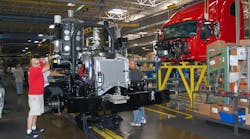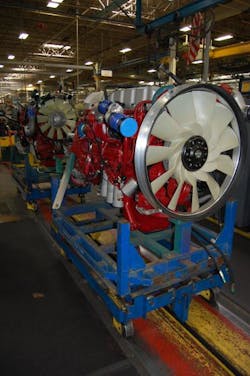Trucking OEMs, suppliers, trade groups, and fleets in the main seem “cautiously optimistic” regarding eventual compliance with the final Phase 2 greenhouse gas (GHG) and fuel efficiency rules issued this week by the Environmental Protection Agency (EPA) and the National Highway Traffic Safety Administration (NHTSA), though in some cases the final rules benchmarks are tougher than what the agencies proposed in the draft phase of the rulemaking process.
[NOTE: to read the entire 1,690 page final Phase 2 rule, go here. To read through the detailed 1,116 page “regulatory impact analysis” of the final rule, go here. For the simplified 5-page fact sheet concerning the Phase 2 rules, go here. To review the specific modeling programs used by EPA and NHTSA for gauging compliance with the new rule, go here and here, respectively.]
Sean Waters, director of compliance and regulatory affairs at Daimler Trucks North America (DTNA), pointed out in a statement that improving overall efficiency for Class 7 and 8 tractors and vocational vehicles by as much as 25% over the course of more than a decade as called for by the new rules “is a tremendous challenge for an industry that has been treating fuel efficiency as a first order priority for our customers for many decades.”
He added that the up to 5% engine efficiency improvements included in the overall efficiency Phase 2 target will require “continued development of engine technology” as well, though he stressed DTNA is “confident that we are up to the challenge.”
The Truck Renting and Leasing Association (TRALA), for one, is concerned that the final rule “appears to have more stringent benchmarks” than the original proposed rule, yet is pleased that 2027 remains “the final target date” for full compliance as both EPA and NHTSA had considered “speeding up that process” by making the final date 2024.
“We are pleased that the EPA and NHTSA granted our request to have the final implementation year of Phase 2 remain in 2027,” noted Jake Jacoby, TRALA’s president and CEO, in a statement. “We’re also pleased that there appears to be harmonization of standards and some additional flexibility for the OEMs to reach these targets."Glen Kedzie, vice president and energy and environmental counsel for the American Trucking Associations (ATA) trade group, added that industry representatives worked with EPA and NHTSA for three-and-a-half years to ensure Phase 2 standards took into account “the wide diversity of equipment and operations across the trucking sector,” which he believes remains the case.
“We are pleased that our concerns such as adequate lead-time for technology development, national harmonization of standards, and flexibility for manufacturers have been heard and included in the final rule,” he said in a statement.
“While efficiency milestones for vehicles, engines and trailers have all been slightly increased over the agencies’ initial proposal, we are encouraged that they addressed several important issues in the final rule including undertaking annual rule assessments, not accelerating compliance timelines from those originally proposed and refining emissions modeling based on industry data,” Kedzie stressed.
“However, while the potential for real cost savings and environmental benefits under this rule are there – fleets will ultimately determine the success or failure of this rule based on their comfort level purchasing these new technologies,” he said.
Yet the American consumer is also expected to benefit from the Phase 2 rules as well, according to the Consumer Federation of America (CFA), largely due to lower fuel usage by freight-hauling trucks. For example, CFA calculates that the average American family spends more than $1,100 per year on indirect freight truck fuel costs passed on to consumers.
“That’s almost as much as the average family spends on household electricity,” stressed Jack Gillis, CFA’s director of public affairs and vehicle expert, in a statement.
“For a long time, an efficiency gap has forced consumers to pay the freight for inefficient shipping,” he said. “These standards will save consumers money, just as other energy efficiency goals have saved families and businesses money on the total cost of owning and operating cars, light-duty trucks, and home appliances such as refrigerators and water heaters.”




